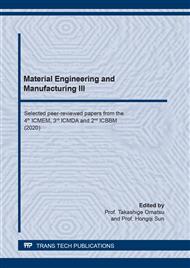p.25
p.31
p.37
p.43
p.49
p.54
p.63
p.69
p.75
Effects of Glycine, L-Arginine and their Complexation with Polyvinylpyrrolidone on Tetrahydrofuran Hydrate Formation
Abstract:
Hydrophilic amino acids as a new type hydrate inhibitor is a hot topic for scholars. In this paper, the influence of glycine and L-arginine, and their complexation with polyvinylpyrrolidone (PVP) on hydrate formation were clarified by tetrahydrofuran (THF) hydrate formation simulation experiments, and the intrinsic influence mechanism was revealed by many experimental methods. The results show that glycine has a strong inhibitory effect on water molecules because of its strong disturbance to water molecules, and the inhibitory effect is the best when the addition of glycine is 1.0 wt%. Due to the disturbance and binding of hydrophilic amino acids to water molecules, the effect of PVP on the semi-cage structure of water molecules as well as the adsorption and encapsulation of hydrate crystal particles, the combination of glycine and L-arginine and PVP has synergistic inhibitory effect on the formation of THF hydrate. When the total amount of hydrate inhibitor is 1.0 wt%, the synergistic inhibition ability of glycine and PVP is stronger. The results obtained in this paper provide an experimental and theoretical basis for the research and development of new hydrate inhibitors.
Info:
Periodical:
Pages:
49-53
Citation:
Online since:
August 2020
Authors:
Price:
Сopyright:
© 2020 Trans Tech Publications Ltd. All Rights Reserved
Share:
Citation:


